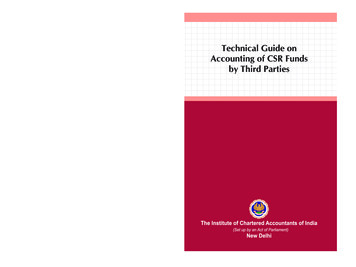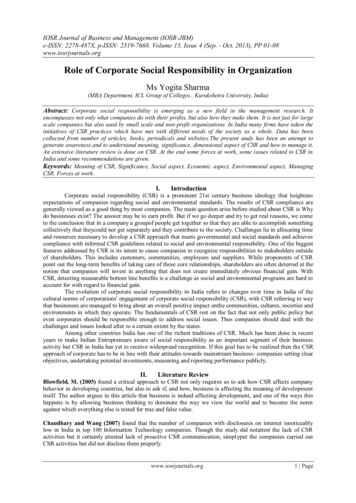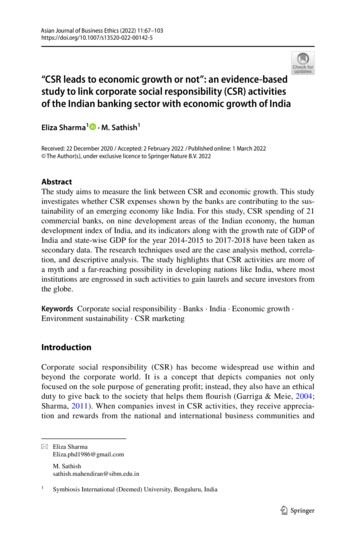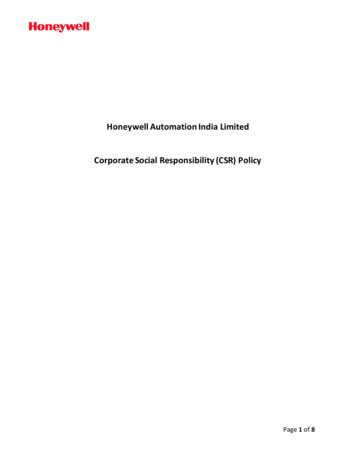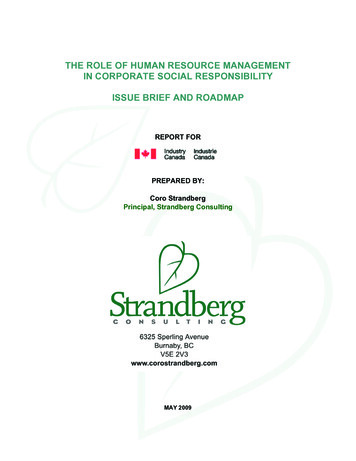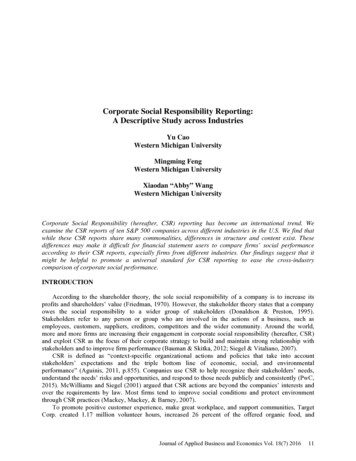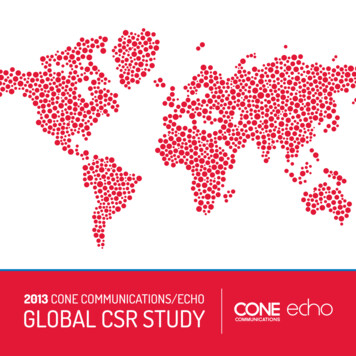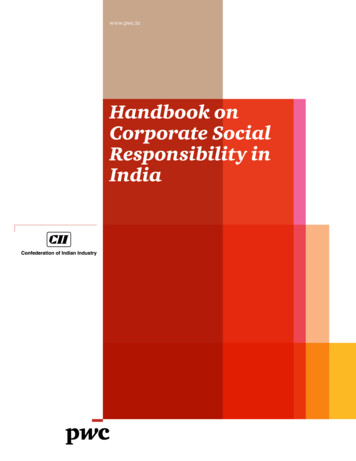
Transcription
How does CSR influence a firm’s profitability?- A case study of SandvikYingxi Jiao, Wenjun XieJune, 2013Student thesis, Bachelor, 15 HEIndustrial engineering and management(Degree project for a Bachelor of Science with major in Industrial engineering and management)Industrial Engineering and Management
ACKNOWLEDGEMENTWe would like to express thankfulness to those who helped us going through the wholeprocess of writing this dissertation. Our first appreciation should be toward to our supervisor,Weihong Wang. This dissertation would not have been possible without the patient guidanceand incessant encouragement of Weihong. We also want to acknowledge our gratitude toKaisu Sammalisto and Agneta Sundström. That is because the idea of the research in thisdissertation is based on their beneficial lectures of the course Sustainability Management. Thecourse deepened the understanding about the CSR in our mind and leads us to think about therelationship between CSR and profitability. Next, we would like to thank the head of CSR ofSandvik, Christina Båge-Friborg for taking the time for us to have a telephone interview inher busy working schedule. Besides, we also feel grateful to Peter Lindberg and Mats Ryding,the teachers of financial accounting in the University of Gävle, who gave us a hand to ensurea correct calculation for ROA, ROE and ROS. At last, our thanks should go to the departmentof Industrial Development, IT, and Land Management at University of Gävle for the supportand course arrangement, especially the course of Scientific Writing. We not only learneduseful knowledge in the main subjects areas, but also learned how to write an academicstructured project and dissertation during the long time stayed in the program.Gävle, June 2013Yingxi Jiao, Wenjun Xie
ABSTRACTWith the increased concentration on the corporate social responsibility (CSR), firms are notonly required to focus narrowly on generating profit returns for shareholders, but also asked totake responsibilities for firms’ other stakeholders, e.g. customers, employees, society etc.,from social, environment and economic perspectives. Hence, nowadays, both having a decentCSR performance and adding profitability are the significant aspects for the company toachieve the sustainable success in the long term. In terms of that, this dissertation aims toexplore the CSR-profitability relationship, namely, to explore how does CSR influence thefirm’s profitability. After reviewing related literature, and choosing the single-case researchmethod, collecting and handling quantitative and qualitative data analysis, findings are: (1)the CSR-profitability relationship in the case company is not clear in last five years; (2) theprior finding shows ambivalent view and inconsistency with the positive mediating process, aprocess used to define the CSR-profitability association, of the case company. Afterdiscussion of the findings, this study concludes that: (1) the CSR-profitability relationshipcannot be clearly defined due to the complex mediating process and direct or indirect effectsfrom tangible/intangible mediating factors; (2) generally, it is not likely to measure thefinancial impacts from the whole CSR performance, but, the financial impacts can bemeasured project by project; (3) those intangible resources that related to the CSR cannot bemeasured; (4) the inconsistent result from the finding may due to some other reasons, e.g. theproblem of depending on accounting-based approach to measure the financial impacts fromCSR, influence from specific financial crisis, lacking comprehensive measurement system ofCSR etc.Key words: Corporate Social Responsibility (CSR), profitability, CSR-profitabilityrelationship.
CONTENT1 INTRODUCTION.11.1 BACKGROUND.11.2 RESEARCH PURPOSE.22 M ETHODOLOGY.32.1CASE STUDY.32.2DATA COLLECTION.52.2.1 Collecting quantitative data.52.2.2 Collecting qualitative data - Interview.62.3 DATA HANDLING.72.4 VALIDITY AND RELIABILITY.73 THEORETICAL FRAM EW OR K.93.1 INTRODUCTION.93.2CSR DEFINITION.93.3 STAKEHOLDER THEORY.103.4MOTIVATION AND IMPACTS OF IMPLEMENTING CSR.113.5THE RELATIONSHIP BETWEEN CSR AND PROFITABILITY.133.5.1 CSR-profitability relationship.133.5.2 Profitability-CSR relationship.153.5.3 Understanding the relationship.153.6THE FINANCIAL IMPACTS FROM CSR.164F INDINGS OF THE CASE STUDY.214.1A BRIEF INTRODUCTION TO SANDVIK.214.2 STAKEHOLDERS IN SANDVIK.224.3 HOW DOES SANDVIK WORK WITH CSR.234.4THE QUATITATIVE DATA OF CSR-PROFITABILITY RELATIONSHIP IN SANDVIK.264.4.1 The data for financial performance.274.4.2 The data for main CSR performance.284.4.3 Comparison of results.304.5THE QUALITATIVE DATA OF CSR-PROFITABILITY RELATIONSHIP IN SANDVIK.324.5.1CSR influences profitability in a negative way.324.5.2 CSR influences profitability in a positive way.334.6SUMMARY OF CASE STUDY.345D ISCUSSION.365.1THE MEDIATING PROCESS.365.2 THE REASONS FOR INCONSISTENT FINDINGS.395.3 SUMMARY OF DISCUSSION.416C ONCLUSION.426.1CONTRIBUTION OF THE RESEARCH.426.2LIMITATION OF THE RESEARCH.436.3FURTHER STUDIES.43
7R EFERENCES.448 APPENDIX.49APPENDIX 1. CAULCULATION OF ROS, ROA AND ROE.49APPENDIX 2. INTERVIEW QUESTIONS.51
1 Introduction1.1 BackgroundFrom the neo-classical economic point of view, put forward by Friedman (2009), a wellknown researcher in CSR area, the only one social responsibility for a business is to utilize itsresources and activities to increase companies’ profit (ibid.). It suggests that the socialresponsibility of a firm is maximizing the profits, and the overall aim of business managers isto maximize the profit return in order to satisfy the expectations from firm’s shareholders,people who own the firm (Friedman, 1970, cited in Kolstad, 2007; Kolstad, 2007; Pava &Krausz, 1996). Those common investors of a firm hope to get higher-level cash returns and asolid corporate financial performance with lower risks.However, the increased attention on the Corporate Social Responsibility (CSR) across firmsand industries requires a firm not only concentrating on adding profit, but also focusing on itssocial responsibilities so that to meet the expectations of various stakeholders, e.g. customers,suppliers and employees (Ruf et al., 2001; Kolstad, 2007; McWilliams & Siegel, 2000;Gatewood & Carroll, 1991; Freeman, 1999). Thus, nowadays, firms need to behave in a moreethical way, with broadly considering different goals except merely considering profitmaximization (Orlitzky et al., 2003; Verschoor, 1998). Whereas, most often, the investment inCSR cuts a firm’s bottom line of making profit because firms cannot always get returns fromtheir social activities (Kolstad, 2007).Nevertheless, what type of relationship exists between CSR and firm’s profitability? Do thoseCSR initiatives influence the firm’s profitability in positive, negative or even neutral way? Itis an interesting topic since this question somehow puzzles companies who implement CSRand want to have a balance between its CSR performance and financial performance. Despitethe great interest, this is also a controversial topic since there is a number of empirical studiesbased on different variables from different scholars show different results and opinions on it.Some scholars claim that there is a positive relationship between the CSR and profitabilitywhile others’ studies show that CSR has a negative relationship with making a profit or norelationship.However, majority of empirical researches merely focus on measuring the relationshipbetween corporate social responsibility (CSR) and profitability/financial performance in orderto identify whether the association is positive or negative. Only a few of researches pay moreattention to the internal connection to explain how the relationship between CSR andprofitability emerges. The process of explaining the how question is regarded as a mediatingprocess according to Surroca et al. (2009) and Peloza (2009). In that mediating process, bothintangible resources, e.g. innovation, brand value, customer loyalty etc., and tangibleresources, e.g. costs for energy use and water consumption etc., have impacts on therelationship, and help to define the relationship between CSR and profitability. Hence, it is1
also significant and necessary to analyze and deepen the understanding about how does CSRinfluence the profitability, in order to explain the causality in the relationship between CSRand firm’s profitability.Understanding the financial effects of a company’s CSR initiatives helps to define therelationship between CSR and profitability. Therefore, in this dissertation, the authors aregoing not only to identify the relationship between the CSR and profitability, but also to focuson exploring and explaining the causal financial effects from CSR in the case company,Sandvik.1.2 Research purposeThe overall aim of this dissertation is to gain an understanding of how CSR has impacts onthe firm’s profitability, with a view to referencing a case company, Sandvik. The followingresearch objectives have been identified of paramount importance in helping to achieve theaforementioned purpose.l l l Review the corporate social performance of the case company.Evaluate the relationship between CSR and profitability through the case study.Explore how CSR influence a firm’s profitability in general.2
2 Methodology2.1 Case studyThe empirical study of this dissertation focuses on an in-depth study of exploring how doesCSR have impacts on the firm’s profitability according to the overall research purpose andobjectives. Thus, the main idea of this research is to explain the causality between CSR andprofitability through, firstly, defining the CSR-profitability relationship and then exploring thereasons behind the relationship or exist between these two variables.There are many research strategies, e.g. survey, experimental research, historical research etc.(Biggam, 2011), provided for authors to choose. However, the research strategy used in thisdissertation is a case study, because (1) Historical research focuses on the events thatoccurred in the past or the non-contemporary phenomenon, but this dissertation focuses on thecontemporary event; (2) Survey is not appropriate since it is used when the author needs therepresentative views in a particular type of population; (3) Experimental research is also notappropriate since it tends to test a hypothesis by doing some type of experiments, and it isalways in the domain of science.Case study is one of the widely used research methods by students. According to Yin (2008,p.18), case study is defined as the “empirical inquiry that investigates a contemporaryphenomenon within its real-life context, especially when the boundaries between phenomenonand context are not clear evident.” Besides, a case study also is used to do some in-depth andinvestigative study (Biggam, 2011). This dissertation not only intends to identify therelationship between CSR and profitability, but also explain the casual relationship. The mainproblem, how does CSR influence the firm’s profitability, is not clearly defined, eve thoughthere are many empirical studies and researches have been done. This dissertation also is anempirical inquiry that observes CSR performance in the real-life context. Consequently, it issuitable for this dissertation to use a case study method to have a deep interpretation andexploration for the case company.In addition, since case study can be divided into a single case study and multiple case studies(i.e. more than one case), this dissertation used the single-case design. By means of the singlecase approach, the authors hope to identify and explore CSR-profitability relationshipintensely to a single case.Based on the views from Yin (2008), single-case study and multiple-case study are suitablefor using under different conditions and considerations (Yin, 2008, p.52, p.60):Thesingle- 3
d)revelatoryor(e)longitudinalpurpose. useofmultiple- y In most research, multiple-case seems to be preferred over a single case study. However, fromthe authors' view, it is suitable to focus on one case and analyze it in detail. Just like focusstrategy, barely concentrate on one target and master it in a flexible way (Yin, 2008).Moreover, compared with multiple-case design, single-case requires less extensive recourseand time. In addition, by the definition mentioned above, some specific situations, e.g. thecritical case, rare case etc., can only be used in a single case study. Because of the specificsubject analysis that probably influenced by some corporate characteristics and outside factorsthat will be mentioned in the theory section, e.g. industry type, company size etc., and thetime limitation, a single-case deign is more suitable than the multiple-case in this dissertation.After deciding the case study strategy, the next step is to design or choose the case unit.Before that, it is necessary to make sure the case is relevant to the objectives and problems inthe dissertation (Yin, 2008). In this empirical study, the Swedish global large company,Sandvik AB is chosen as the case company or the case unit because (1) Sandvik is a globalsuccessful company who works on CSR for a very long time. As a result, the data andinformation related to the research subjects are more completed and structure-collected thanother companies who do not implement CSR; (2) The company located around Gävle citywhere the authors had a study visit to the company before, and it is convenient for the authorsto have more chance to meet with the company.However, adopting a case study research cannot avoid some criticisms and limitations, whichshould be addressed. First of all, the case study provides little basis for the scientificgeneralization, which is achieved through continuously repeating those case studies (Yin,2008). In this dissertation, the case study lacks the generalization that to apply the resultfindings and analysis on other companies in the same situation. Nevertheless, the authors wantto deepen the knowledge understanding about the CSR-profitability relationship. The casestudy strengthens the aim of the research. Secondly, case study is criticized for lacking rigorbecause case study allows some suspicious evidence and views to influence the findings. Forexample, in this study, choose of the measurement metrics for measuring the financial impactsfrom CSR activities can influence the outcome results. Thirdly, the case study, especially thesingle-case design, bears the fear of “putting all your eggs in one basket” (Yin, 2008, p.61),which means, in general, the criticism is the uniqueness or artifactual conditions about thecase (Yin, 2008).4
2.2 Data collectionAfter deciding to apply the case study strategy in this dissertation, some quantitative data andqualitative information related to the research objectives are collected, through reviewing thecompany’s reports and generating a telephone interview with the case company.2.2.1 Collecting quantitative dataThis dissertation is going to analyze the relationship between CSR and firm’s profitability,and it is required to collect some quantitative data about the firm’s financial performance andCSR performance. Those data was mainly collected from the company’s official reportsbecause reviewing the firm’s annual reports and other corporate documents are the mainmethod to have a content analysis to firm’s overall performance (McGuire et al., 1988;Cochran & Wood, 1984). However, such types of documents often have more publicationvalue than the information value, so that the actual firm’s performance may be uncertain(McGuire et al., 1988).First of all, the statistical data about the key CSR initiatives were collected. Due to reason that,some data that indicates the CSR performance, e.g. amount of energy use, produced waste etc.,in the sustainability reports before 2008 were measured in a different unit, this research onlycollected those data from year 2008 till 2012. Apart from that, as a result of lacking statisticaldata on the one hand, and environment, health and safety (EHS) is also emphasized byPeloza’s (2009) research and Sandvik itself on the other, this dissertation chose the EHS asthe main performance indicator for measuring the CSR performance in the Group, so as todefine the statistical relationship between CSR and profitability.Following, according to Weetman (2006), some quantitative data, e.g. net income, revenue,shareholder’s equity etc., that used to measuring the financial performance of Sandvik arecollected from company’s annual reports from the year 2008 till 2012. Before that, it is shouldbe stated clearly that why choose to collect such data. There are three measures can be used tomeasure the final financial performance from the CSR performance in a company, marketbased approach, accounting-based approach and perceptual approach. They will be describedin the section 3.6. As a result of the methodological problem for measuring the financialimpacts or profitability of CSR, the authors of this dissertation decided to choose theaccounting-based method to measure the profitability of Sandvik. Since every approach hasdifferent advantages and disadvantages for the method itself, see the section 3.6, it was hardfor authors have a choice based on that. Therefore, the reasons for choosing were mainlybased on the data availability and the feasibility of the approach: (1) the data and information,e.g. mutual fund returns, used in the market-based result are not allowed to be published toauthors; (2) if use the perceptual approach, the accurate reputation ranking of the casecompany, Sandvik, cannot be found; (3) the data used in the accounting-based approach isclearly stated in the annual report of Sandvik. After deciding the method for measuring the5
financial performance of the Group, the detail calculating process and results are respectivelypresented in Appendix 1 and section 4.4.1.2.2.2 Collecting qualitative data - InterviewWhen applying the case study research, it is the nature that this dissertation is a qualitativeresearch. Except reviewing the annual report and sustainability report of Sandvik in order togain an overview of its CSR performance, interview, one of the most essential sources of casestudy (Yin, 2008), is mainly used as the technique of collecting qualitative data to explain thecausality and relationship between CSR and profitability from the Group’s point of view.The qualitative data is collected from the semi-structured interview, which outlinesfundamental questions of the audience in advance, and interviewers hope to elicit meaningfulinformation from the respondent (Gubrium & Holstein, 2002). A good case study interviewnot only require that the interviewers follow the line of their inquiry, but also simultaneouslyput the friendly questions in the interview (Yin, 2008). Therefore, there are two tasks shouldbe prepared well for interviewers before the interview beginning, in order to have a smoothinterview (Gubrium & Holstein, 2002). The first is to persuade the interviewee to agree to beinterviewed. After a few times email-contact with the head of CSR in Sandvik, ChristinaBåge-Friborg, we got permission to take 30 minutes phone interview. The second task is tocollect information about the case or case company and prepare the questions list that relatedto the research problems in advance. Through reading about Sandvik's sustainable reports,annual reports and other information, an introduction of the Group, an overview of its CSRwork are taken in mind and stated in the finding part.Moreover, according to Yin (2008), a focused case study interview, in which the intervieweewill only be interviewed for a short time, e.g. one hour, the interviewers are supposed toprepare a careful-worded question list so that they can follow that and still make the interviewopen-ended. Specially noted in this dissertation, since the core financial information is thecommercial secret for the company, and it is normally not allowed to express it to the outside,so those questions relate to the financial performance are sensitive question to be asked. Sothat, interviewer did not pretend to expand more financial questions in depth and pay moreattention to Sandvik CSR performance instead. Consequently, five interview questions thatmainly focus on financial impacts of those CSR initiatives, e.g. environment, health, andsafety, were generated after going through the case. The full list of the interview questions ispresented in the Appendix 2. Furthermore, due to time limitation during the interview,interview questions were clearly defined and sent to the interviewee, the head of the CSR ofSandvik, by the e-mail in advance. As a result, the time would be saved since both interviewerand interviewee are ready for the interview.Nevertheless, some pros and cons of interview or telephone interview also need to beaddressed in the whole research process. Interview is target-focused and insightful throughdirectly focusing on the case study or the research topic, and providing causal explanations6
(Yin, 2008). In this dissertation, the interview with the CSR manager helped authorsexploring and finding out the courses in the relationship between CSR and profitability, inSandvik. Additionally, by comparing with other interview forms, phone interview is cheaper,convenient and easier to administer with respondent (Gubrium & Holstein, 2002). Besidesthese strengths of the interview, there are also some weaknesses emerge. During a telephoneinterview, some limitations, e.g. bad the calling signal that cause the hearing issues, poorrecall, less thoughtful responses are received, and visual clues are absent etc., which maybring response bias, are stated by Gubrium & Holstein (2002) and Yin (2008).2.3 Data handlingIn terms of the data handling, some simple statistic line charts are generated by the MicrosoftExcel in the section of findings, according to the collected data. Moreover, this dissertationmeasures the firm’s profitability or financial performance from CSR through calculating somemain factors, e.g. return on assets (ROA), return on equity (ROE) and return on sales (ROS).The calculating process is based on the literature book of financial accounting from Weetman(2006) and is approved by Peter Lindberg and Mats Ryding, the teachers from the accountingdepartment of the University of Gävle. Moreover, the detail calculating procedure andformulas that readers can easily repeat the work is displayed in the Appendix 1.2.4 Validity and reliabilityAccording to Biggam (2011), validity and reliability are two aspects that researchers shouldtake care for the study quality. It is necessary to show why the research is valid empiricalresearch and why it can be relied (ibid.). In order to establish the validity and reliability ofcase study evidence, the authors strictly follow three principles: (1) Using multiple sources toestablish data triangulation such as empirical interview, financial performance indication,official website report and other news clipping from mass media. (2) Creating a case studydatabase - the way of organizing and documenting the data is from the official website. (3)Maintaining a chain of evidence - each data should be traced from the source (Yin, 2008).ValidityValidity refers to choosing the correct and appropriate methods for the research (Biggam,2011). The use of every approach should be suited to activities occur in the research process,from selecting the research strategy to collecting the useful data (ibid). In this dissertation, allactivities - selecting the single-case-study strategy, having an interview approach to collectqualitative information, reviewing scientific literatures, collecting statistical data about thecase company and choosing the accounting-based approach to measure the CSR, aresupported with reasonable motivations and suitable explanations so that to make sure everyapproach is valid enough and the dissertation follows a correct way.7
ReliabilityDifferent from the validity, reliability is about whether the research is reliable and trusted(Biggam, 2011). This dissertation starts with reviewing relevant literature, and taking thewell-known researchers' views as evidence, in order to guarantee the reliability of the criticalevaluation. Moreover, a large number of official published secondary data and empiricalinterview provide a rich picture of Sandvik's CSR performance and help to identify therelationship between CSR and profitability. Furthermore, since there are some calculationsoccur in measuring the overall financial performance (return on assets (ROA), return onequity (ROE), return on sales (ROS)) of the case company, the calculating process and resultsare approved by two financial accounting teachers from the university in order to ensure thatthe calculating results are corrected and trusted.8
3 Theoretical Framework3.1 IntroductionLiterature review is essential for doing an empirical study as it not only lays out what researchhas been done by others relevant to the research objectives, but also present the strongevidence for the in-depth critical evaluation to the research topic (Biggam, 2011). In thisdissertation, the authors are going to explore how CSR has impacts on the firm’s profitability,through achieving three objectives, see the section 1.2. Based on the research objectives, fouraspects are regarded as the main focuses when reading the literatures: (1) The definition ofCSR; (2) The benefits or motivation to implement CSR; (3) The relationship between CSRand profitability; (
course deepened the understanding about the CSR in our mind and leads us to think about the relationship between CSR and profitability. Next, we would like to thank the head of CSR of . only required to focus narrowly on generating profit returns for shareholders, but also asked to take responsibilities for firms' other stakeholders, e.g .
